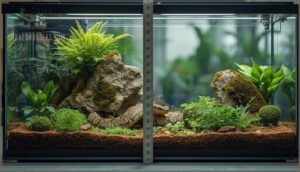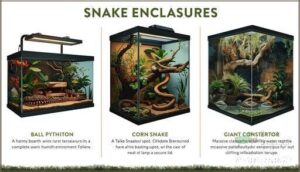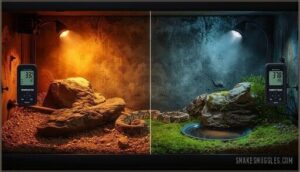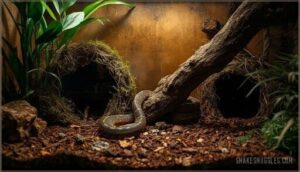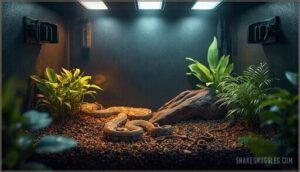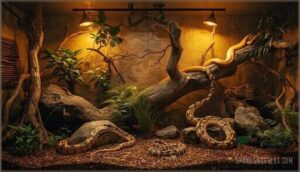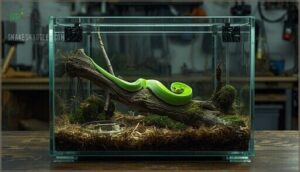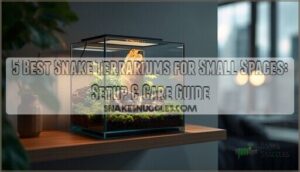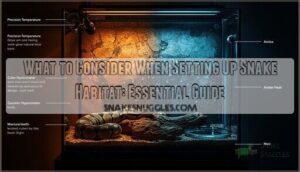This site is supported by our readers. We may earn a commission, at no cost to you, if you purchase through links.
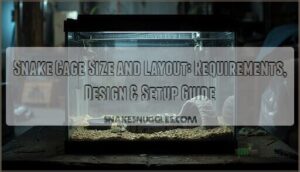
Table Of Contents
- Key Takeaways
- Snake Cage Size: Why It Matters
- Minimum Enclosure Size Requirements
- Species-Specific Enclosure Dimensions
- Optimal Snake Cage Layout and Design
- Building and Maintaining Snake Enclosures
- Frequently Asked Questions (FAQs)
- How to choose a snake cage size in metric measurements?
- How big should a snake enclosure be?
- How long should a snake cage be?
- What should a snake cage include?
- How do I choose a snake enclosure?
- How do you house a snake in a cage?
- How do you transition a snake to a larger enclosure?
- What lighting schedule works best for nocturnal snakes?
- Can multiple snakes share one enclosure safely?
- How often should substrate be fully replaced?
- Conclusion
Key Takeaways
- Your snake needs an enclosure at least as long as its full body length—anything shorter leads to 28% more shedding problems, 46% more escape attempts, and increased stress behaviors like substrate burrowing.
- Scientific evidence from 65 publications shows that 25 peer-reviewed sources recommend minimum cage dimensions matching full snake length, while only 6 suggested smaller sizes without empirical backing.
- Undersized enclosures affect over half of pet snakes and cause measurable health consequences including 11% higher parasite rates, 6% more respiratory disease, and stunted brain development from restricted movement.
- Species-specific dimensions matter: adult ball pythons need 4’x2’x2′ minimum, corn snakes require 48″x24″x24″, and giant constrictors demand custom builds with at least one square foot of floor space per foot of snake length.
Snake Cage Size: Why It Matters
Your snake’s cage size directly affects its health, behavior, and lifespan. Too small, and you’re looking at stress responses, failed sheds, and musculoskeletal problems—issues backed by research showing over half of pet snakes live in undersized spaces.
Here’s what the science says about proper enclosure dimensions and why skimping on space isn’t worth the risk.
Impact of Cage Size on Snake Health
Your snake’s cage size directly affects its physical and behavioral health. Snakes housed in enclosures shorter than their body length show 28.2% more shedding problems, 45.9% more escape attempts, and 52.1% more stress-related substrate burrowing.
Snakes in cages shorter than their body length suffer 28% more shedding problems and show dramatic increases in stress behaviors
Inadequate cage size for a snake prevents proper thermal gradients and restricts natural movement, leading to health risks like respiratory issues and parasitic infections. Without proper humidity levels and space to stretch fully, animal welfare declines markedly.
Providing an ideal snake enclosure involves understanding the importance of enclosure size effects on their behavior and welfare.
Scientific Guidelines and Industry Recommendations
Research findings show clear evidence for larger enclosures. A 2021 review of 65 publications found that 25 peer-reviewed sources supported cage size for a snake at least equal to full body length, while only 6 recommended smaller dimensions—none backed by empirical data.
Veterinary organizations like the British Veterinary Association now formally endorse minimum enclosure size at or above one body length, and industry consensus from the Federation of British Herpetologists to the RSPCA reflects this evidence-based standard for snake welfare and development.
The importance of snake stretching needs is a key factor in determining the appropriate cage size for snakes.
Risks of Undersized Enclosures
When your snake doesn’t have room to stretch out, the consequences add up fast. Studies show that 54.7% of pet snakes live in cages shorter than their bodies—and those animals suffer. You’ll see stress-related behaviors like head-hiding under substrate (52.1%), escape attempts (45.9%), and repeated boundary-pushing.
Health issues spike too: shedding problems affect 28.2% of snakes in cramped spaces, parasites hit 11.2%, and respiratory disease strikes 5.6%. Undersized minimum enclosure size also increases mortality rates, weakens disease susceptibility, and disrupts snake development by stunting cognitive impacts and brain growth—proving that cage size for a snake directly shapes health consequences.
Minimum Enclosure Size Requirements
Getting the cage size right isn’t guesswork—it’s about meeting your snake’s physical needs at every stage of life. Whether you’re setting up for a hatchling or an adult, you’ll need to understand how enclosure dimensions relate to body length and age.
Let’s break down the three key rules that guarantee your snake has the space it deserves.
General Rules for Measuring Cage Size
You don’t need guesswork when choosing the right cage size—measurement standards provide clear benchmarks. Your snake enclosure must meet spatial requirements based on body length, not approximations.
Species-specific enclosure requirements and measurement standards prioritize welfare. Enclosure dimensions under one body length restrict natural behavior and compromise health.
- Measure the full snake length from snout to tail tip, not just snout-to-vent, to determine minimum enclosure size accurately.
- Length equals movement: The enclosure’s longest dimension should match at least one full body length so your snake can stretch completely.
- Combine length and width to equal or exceed total snake length—this ensures turning and natural locomotion patterns.
- Calculate enclosure volume by multiplying internal dimensions, accounting for thermal gradients and vertical space for semi-arboreal species.
- Reassess at every growth stage: Cage size calculations must adapt as juveniles mature, with measurements repeated after each shed.
Age-Based Size Guidelines (Juvenile Vs. Adult)
Your snake won’t outgrow its needs overnight, but ignoring growth rates means playing catch-up with health problems. Juvenile snakes require smaller, secure spaces that prevent stress, while adult snakes demand room to stretch fully—and the shift between these stages follows predictable patterns you can plan for.
| Life Stage | Typical Dimensions | Shift Timing |
|---|---|---|
| Hatchling ( 3 ft) | 48 × 24 × 24 in | 24+ months onward |
Ball python hatchlings thrive in 20-inch enclosures, but once they hit 3 feet around 18–24 months, you’ll need to upgrade to 48-inch habitats. Corn snakes follow similar age thresholds, reaching 4–5 feet by year three and requiring 40- to 60-gallon spaces.
Reassess enclosure dimensions every six months during rapid growth phases—snakes confined below one body length show 40–60% less movement and delayed feeding. Enclosure resizing isn’t optional; it’s how you prevent musculoskeletal stress and support snake development through each size shift.
Full Body Length Principle Explained
Your snake’s ability to stretch fully isn’t a luxury—it’s a welfare requirement. Enclosure dimensions must equal or exceed one full snake length in the longest direction, allowing complete rectilinear extension without obstruction.
Snakes housed below this threshold show 45–60% increases in stress behaviors, musculoskeletal issues, and compromised thermal gradients.
Choosing the right cage size means measuring your snake’s total body length, then building enclosure design around that minimum, ensuring natural behavior patterns remain intact throughout daily activity cycles.
Species-Specific Enclosure Dimensions
Different snake species need different enclosures, and getting the dimensions right matters for your snake’s health. Ball pythons, corn snakes, and giant constrictors each have their own space requirements.
Here’s what you need to know for the most common species.
Ball Python Minimum Cage Size
Your ball python’s home needs to match its size—period. Adult ball pythons require a minimum enclosure of 4’x2’x2′ (about 120 gallons) to thrive, which accommodates their full body length and natural movements. Studies show that snakes housed in properly sized habitats exhibit 37% more natural behaviors and 40% higher feeding success rates, directly improving snake welfare.
Here’s what you need:
- Hatchlings (under 300g): 10-gallon tank (20″ x 11″ x 13″)
- Juveniles (under 3 ft): 40-gallon setup (36″ x 18″ x 18″)
- Adults (3–5 ft): Minimum 48″ x 24″ x 24″ enclosure
- Large females (5–6 ft): 5’x3’x3′ (150–200 gallons) for full extension
Ball python minimum enclosure size matters because undersized cages increase stress behaviors by 42% and incomplete sheds by 18%. The enclosure dimensions must allow thermal gradients, proper humidity levels, and adequate enclosure depth for substrate options that support burrowing. Don’t shortchange your snake’s space—it’s the foundation of everything else.
Corn Snake and Leopard Gecko Requirements
You’ll need different dimensions for corn snakes versus leopard geckos—each species has its own blueprint. Adult corn snakes require a minimum 48″x24″x24″ enclosure (about 120x60x60 cm), matching their 3–5 foot body length and supporting climbing behaviors, while adult leopard geckos thrive in 36″x18″x18″ setups with at least 4.5 square feet of floor space.
Both species benefit from enriched reptile enclosures with proper temperature gradients, multiple hides, and substrate depth of 3–4 inches to promote natural behaviors and improved reptile welfare through thoughtful enclosure design and animal enrichment.
Giant Snakes and Large Monitors
When you’re housing powerful constrictors or active monitors that can exceed 6–8 feet, enclosure security becomes as critical as size. Adult Burmese pythons need at least 8’x4’x4′ (32 sq ft floor space), while ackie monitors require 5’x2.5’x4′ enclosures with enrichment features—both demand sturdy materials and lockable doors.
- Use one square foot of floor space per foot of snake length as your baseline for large species
- Build enclosures from high-density polyethylene or PVC resistant to warping under high heat
- Install secure, lockable front-opening doors to prevent escape attempts from strong reptiles
- Provide substrate depth up to 24 inches for monitors’ natural burrowing behaviors
- Include climbing structures spanning full enclosure dimensions to support species-specific behaviors and reptile welfare
Custom-built large enclosures often outperform commercial tanks for giant snake care and proper habitat design.
Room Conversions for Large Reptiles
Converting a spare room into a dedicated reptile space allows you to house multiple large species, such as giant snakes and monitors, without compromising individual enclosure dimensions or environmental control. Standard conversions utilize 12’x12′ rooms (144 sq ft minimum) with banked enclosures lining 2–4 walls, providing ample space for heat zones, humidity management, and safe maintenance access.
| Aspect | Specification |
|---|---|
| Room Size | 100–225 sq ft (12’x12′ minimum) |
| Ambient Temperature | 80–82°F with zone thermostats |
| Ventilation Rate | 80–150 CFM exhaust fans |
You’ll need sealed flooring, 4–6 dedicated 20A circuits for climate control, and custom cabinetry for optimal space utilization. Biosecurity measures, including vapor barriers and isolated doorways, are essential to prevent cross-contamination in your custom habitats, ensuring that large reptiles like giant snakes and monitors thrive in well-designed reptile rooms.
Optimal Snake Cage Layout and Design
Getting the enclosure size right is just the first step—how you set up the interior determines whether your snake can actually use that space effectively.
The layout needs to support thermoregulation, natural behaviors, and stress reduction through careful placement of heating elements, hides, and enrichment features.
Here’s what you need to include in a properly designed snake enclosure.
Temperature Gradients and Humidity Control
Thermal balance dictates your snake’s health more than almost any other factor. You’ll need a warm end between 86–90°F and a cool end at 72–80°F to support proper thermoregulation. Heat gradients allow your snake to shuttle between zones and regulate body temperature naturally.
Maintain humidity levels at 60–80% during the day, and monitor temperature fluctuations with digital probes placed at both ends for accurate climate control and heat management.
Hides, Climbing Structures, and Substrate
Once you’ve dialed in your temperature zones, you need to give your snake the right furniture. Place at least two hides—one on the warm side and one on the cool side—so your snake can thermoregulate without sacrificing security. Studies show snakes spend 70–90% of their time in hiding spots when available, and dual-hide setups improve thermoregulation efficiency by 40%.
For climbing options, add branches or platforms if you keep semi-arboreal species like corn snakes; vertical enrichment boosts activity levels by 35%. Substrate depth matters too—aim for at least 5 cm of material like coconut fiber or cypress mulch to allow natural burrowing.
Enriched, naturalistic habitats with proper environmental enrichment double behavioral diversity and reduce stress behaviors by half.
Ventilation and Secure Access Points
Your snake enclosure needs proper airflow to prevent respiratory infections—aim for 6–12 square inches of ventilation in medium-sized cages, with vents placed low on the cool end and high on the warm end to promote natural convection.
Position air vents opposite each other to increase internal air movement by 35%, ensuring you renew 100% of the air every 15–30 minutes without dropping humidity below species requirements.
For secure access points, use interlocking door latches or dual-pin keyed locks to prevent escapes, since snakes can slip through gaps larger than 1 mm.
Lighting and Enrichment Features
Once you’ve dialed in ventilation and security, proper lighting and enrichment complete your setup. Install full-spectrum LED lighting on a 12-hour cycle to support circadian rhythms—position UVB bulbs 9–15 inches above basking spots to promote calcium metabolism without overexposure.
Add thermal gradients by combining climbing branches, multiple hiding spots, and varied substrate for sensory stimulation—snakes in enriched environments show 30% more natural movement and improved problem-solving. Rotate decor monthly and use scent trails to trigger foraging responses, keeping enrichment activities varied.
Building and Maintaining Snake Enclosures
Building your snake’s enclosure from scratch gives you full control over dimensions, materials, and features that match your species’ needs. You’ll need to choose safe construction materials, install proper heating and lighting systems, and establish a maintenance routine that keeps your snake healthy.
Let’s walk through the key steps to create and care for a reliable, long-lasting habitat.
Selecting Safe Materials and Construction Tips
Building a snake enclosure starts with choosing materials that won’t harm your reptile. Non-toxic materials form the foundation of safe construction, so material selection matters more than you might think.
- Use high-density polyethylene or quality PVC panels free of phthalates—these resist humidity and last 20+ years without chemical breakdown
- Seal all wood surfaces with waterproof, non-toxic sealant and let cure for 5–7 days before introducing your snake, reducing harmful compound exposure by over 90%
- Avoid pine and cedar entirely—aromatic woods release hydrocarbons that cause respiratory and neurological problems in reptiles
Measure twice, cut once when building a snake enclosure. Proper enclosure design includes rust-resistant hardware and double-sealed joints with silicone for humidity control.
Setting Up Heating, Lighting, and Ventilation
Three climate control elements work together to keep your snake healthy. You’ll need heating options like ceramic emitters or heat mats, regulated by thermostats, to create proper temperature gradients—warm side at 85–88°F and cool side at 75–78°F. UVB lighting on a 12-hour cycle aids calcium absorption and natural behavior. Ventilation systems require 2–3 vents per 4-foot cage, positioned low on the cool side and high on the warm side for optimal airflow.
Thermal regulation depends on equipment working in sync with your ventilation needs for effective climate control.
| Climate Element | Equipment Options | Specifications | Placement | Safety Notes |
|---|---|---|---|---|
| Heat Sources | Heat mats, ceramic emitters, radiant panels | Warm side: 85–88°F; Cool side: 75–78°F | Heat mats cover 1/3 floor; emitters overhead | Always use thermostats to prevent burns |
| UVB Lighting | 2.0–3.0 UVI bulbs, full-spectrum LEDs | Position 10–18 inches above basking area | Over warm zone at appropriate height | Replace bulbs every 6–12 months |
| Ventilation Needs | Mesh strips, drilled vents (5″x3″) | 2–3 vents per 4-foot enclosure | Low on cool side, high on warm side | Prevents bacterial buildup and balances humidity |
| Temperature Regulation | Digital thermometers, infrared guns | Monitor daily; check multiple zones | Place sensors at substrate level and mid-height | Improper temps cause digestion issues |
| Lighting Cycles | Timers, programmable controllers | 12 hours on/12 hours off standard | Adjust seasonally (11–13 hours) | Mesh tops block 35% of UVB rays |
Cleaning, Maintenance, and Health Monitoring
Daily spot cleaning protects your snake from bacterial buildup and zoonotic diseases like Salmonella, which affects over 57% of pet reptiles. Remove waste immediately, sanitize water bowls daily with F10SC Disinfectant Options or chlorhexidine, and replace substrate weekly.
Proper Waste Management and Humidity Control prevent respiratory illness by 40%.
During Health Checks, watch for smooth shedding cycles, clear eyes, and active tongue flicking—early signs of snake health problems require veterinary attention.
Frequently Asked Questions (FAQs)
How to choose a snake cage size in metric measurements?
Before telegraphs sent urgent messages across continents, people understood that proper enclosure dimensions start with your snake’s body length.
Measure your snake from nose to tail tip, then multiply by 9 for length, 45 for width, and 3 for height—all in centimeters.
How big should a snake enclosure be?
Your snake enclosure should be at least as long as your snake’s full body length. Most experts recommend minimizing stress by providing enclosures where the length plus width equals or exceeds the snake’s total length, allowing proper stretching and natural movement.
How long should a snake cage be?
Your snake cage should be at least as long as your snake’s full body length. This allows complete stretching, which prevents muscle atrophy and facilitates natural movement.
Enclosures matching or exceeding snake length reduce stress-related behaviors and promote healthier thermoregulation across thermal gradients.
What should a snake cage include?
Ironically, the most overlooked feature isn’t what you add—it’s what you forget.
Your snake enclosure needs proper hides (at least two), a secure water bowl, reliable heating elements, adequate substrate depth, and escape prevention measures to support natural habitat design.
How do I choose a snake enclosure?
Your first step is matching enclosure size to your snake’s adult length—aim for at least 5 times body length. Consider species-specific behaviors: arboreal species need vertical space, while terrestrial snakes prioritize floor area.
Environmental factors like temperature gradients and humidity control depend on proper habitat design and enclosure materials that support reptile welfare.
How do you house a snake in a cage?
You’ll need proper cage security with tight-fitting lids, ventilation systems for fresh air exchange, and humidity control matching your species’ needs.
The snake enclosure should include hides, climbing structures, and temperature zones that support natural snake behavior and habitat requirements.
How do you transition a snake to a larger enclosure?
Gradual acclimation is key to stress reduction when upgrading your snake habitat. Move familiar hides and enrichment items into the larger enclosure first, then transfer your snake.
Monitor behavior and feeding schedules closely for two weeks to confirm your snake adjusts to the new space without stress.
What lighting schedule works best for nocturnal snakes?
A 12:12 light/dark cycle works best for nocturnal snakes. Use timers to maintain consistent photoperiods that support natural circadian rhythms and thermoregulation without causing light pollution or health consequences.
Can multiple snakes share one enclosure safely?
As they say, two’s company, three’s a crowd—and in snake care, even two can be trouble. Most experts don’t recommend cohabitation due to serious risks: stress from resource competition, disease transmission through shared spaces, aggression that can lead to injury, and even cannibalism in some species. Your snake’s habitat works best as a solo sanctuary.
How often should substrate be fully replaced?
You should replace substrate every 2-4 months with regular spot cleaning, or every 2-4 weeks for highly absorbent materials in humid setups.
Bioactive enclosures need only spot cleaning since cleanup crews break down waste naturally.
Conclusion
Every snake that outgrows its space or lacks proper layout becomes vulnerable to preventable health issues. Your attention to snake cage size and layout determines whether your animal thrives or merely survives.
Measure enclosures using full body length as your baseline, provide thermal gradients with secure hides, and upgrade as your snake matures. These aren’t optional upgrades—they’re non-negotiable standards.
Get the dimensions right from day one, and you won’t become another cautionary tale about inadequate husbandry.
- https://phys.org/news/2022-07-potential-welfare-privately-snakes.html
- https://reptifiles.com/corn-snake-care-guide/corn-snake-terrarium-size/
- https://talis-us.com/pt/blogs/blog-175/essential-reptile-enclosure-size-guide-for-healthy-pets
- https://www.ottoenvironmental.com/enhancing-snake-welfare-through-environmental-enrichment/
- https://onlinelibrary.wiley.com/doi/10.1155/ijz/3548045

